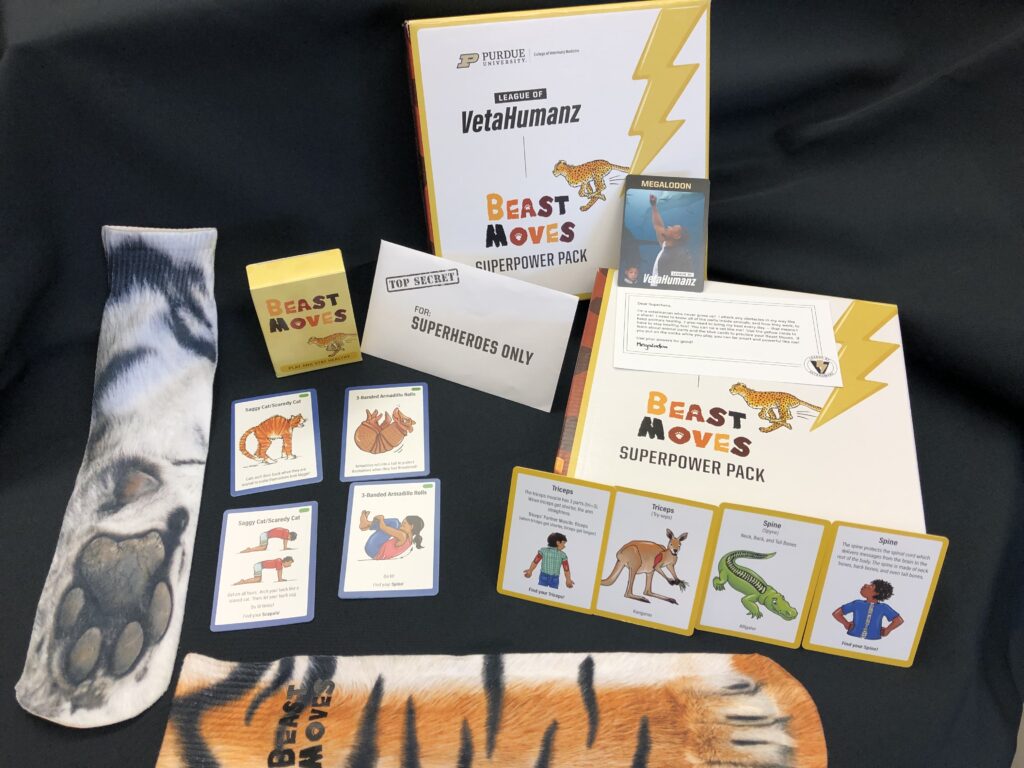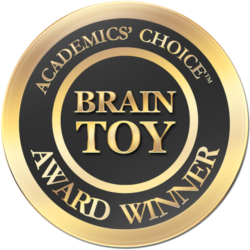Beast Moves! SuperPower Pack
SuperPower Packs are self-guided, educational experiences for kids lacking access to in-person veterinary role models. Each SuperPower Pack contains an activity to help kids engage in veterinary careers by taking on the persona of a veterinary superhero. The Beast Moves! SuperPower Pack helps kids find key muscles and bones and learn about how people and animals use them when they move! Then, kids can practice showing off their Beast Moves with exercise challenges! Thanks to support from NIH NIGMS SEPA and our sponsors we have given thousands of SuperPower Packs to under-resourced children who are participating in our programs.

2022 Academic’s Choice Award Winner
“The Beast Moves SuperPower Pack can be used whenever a movement break is needed. It included interesting facts about a variety of human body parts (muscles and bones) and how animals also use these muscles/bones to perform all sort of different functions. The illustrations are colorful and reflect a diverse group of kids.”
“Even young kids can understand and enjoy learning about animal/human anatomy and it’s also great that it encourages kids to move, play, and stay healthy.”
“Children learn about different muscles and bones, anatomy, physical movement, compare/contrast, healthy habits, and much more.
The Unboxing
About Beast Moves
Beast Moves is game where kids find key muscles and bones and learn about how people and animals use them when they move! Then, kids can practice showing off their Beast Moves with exercise challenges!
- 15+ min
- 1+
- 5+
Play Beast Moves
Follow @pucvm on Facebook, Instagram, TikTok, and LinkedIn for daily Beast Move challenges.
Beast Moves Academic Standards
https://www.nextgenscience.org/
https://www.cdc.gov/healthyschools/health_and_academics/index.htm
Next Generation Science Standards
3rd-5th Grades
4-LS1-1 Construct an argument that plants and animals have internal and
external structures that function to support survival, growth, behavior and reproduction.
National Health Education Standards
PreK-2nd Grade
1.2.1: Identify that healthy behaviors impact personal health.
2.2.1: Identify how the family influences personal health practices and behaviors.
2.2.2: Identify what the school can do to support personal health practices and behaviors.
4.2.1: Demonstrate healthy ways to express needs, wants, and feelings.
4.2.2: Demonstrate listening skills to enhance health.
6.2.1: Identify a short-term personal health goal and take action toward achieving the goal.
6.2.2: Identify who can help when assistance is needed to achieve a personal health goal.
7.2.1: Demonstrate healthy practices and behaviors to maintain or improve personal health.
7.2.2: Demonstrate behaviors that avoid or reduce health risks.
8.2.1: Make requests to promote personal health.
8.2.2: Encourage peers to make positive health choices.
3rd-5th Grades
1.5.1: Describe the relationship between healthy behaviors and personal health.
1.5.2: Identify examples of emotional, intellectual, physical, and social health.
2.5.1: Describe how family influences personal health practices and behaviors.
2.5.2: Identify the influence of culture on health practices and behaviors.
2.5.3: Identify how peers can influence healthy and unhealthy behaviors.
2.5.4: Describe how the school and community can support personal health practices and behaviors.
4.5.1: Demonstrate effective verbal and nonverbal communication skills to enhance health.
6.8.1: Assess personal health practices.
6.8.2: Develop a goal to adopt, maintain, or improve a personal health practice.
6.8.3: Apply strategies and skills needed to attain a personal health goal.
6.8.4: Describe how personal health goals can vary with changing abilities, priorities, and responsibilities.
7.5.1: Identify responsible personal health behaviors.
7.5.2: Demonstrate a variety of healthy practices and behaviors to maintain or improve personal health.
8.8.2: Demonstrate how to influence and support others to make positive health choices.
Common Core Standards-English Language Arts
Kindergarten
CCSS.ELA-LITERACY.RI.K.1With prompting and support, ask and answer questions about key details in a text.
CCSS.ELA-LITERACY.RI.K.3With prompting and support, describe the connection between two individuals, events, ideas, or pieces of information in a text.
CCSS.ELA-LITERACY.RI.K.7With prompting and support, describe the relationship between illustrations and the text in which they appear (e.g., what person, place, thing, or idea in the text an illustration depicts).
CCSS.ELA-LITERACY.RI.K.9With prompting and support, identify basic similarities in and differences between two texts on the same topic (e.g., in illustrations, descriptions, or procedures).
First Grade
CCSS.ELA-LITERACY.RI.1.1Ask and answer questions about key details in a text.
CCSS.ELA-LITERACY.RI.1.3Describe the connection between two individuals, events, ideas, or pieces of information in a text.
CCSS.ELA-LITERACY.RI.1.4Ask and answer questions to help determine or clarify the meaning of words and phrases in a text
CCSS.ELA-LITERACY.RI.1.6Distinguish between information provided by pictures or other illustrations and information provided by the words in a text
CCSS.ELA-LITERACY.RI.1.7Use the illustrations and details in a text to describe its key ideas.
CCSS.ELA-LITERACY.RI.1.9Identify basic similarities in and differences between two texts on the same topic (e.g., in illustrations, descriptions, or procedures).
CCSS.ELA-LITERACY.RI.1.10With prompting and support, read informational texts appropriately complex for grade 1.
2nd Grade
CCSS.ELA-LITERACY.RI.2.1Ask and answer such questions as who, what, where, when, why, and how to demonstrate understanding of key details in a text.
CCSS.ELA-LITERACY.RI.2.3Describe the connection between a series of historical events, scientific ideas or concepts, or steps in technical procedures in a text.
CCSS.ELA-LITERACY.RI.2.6Identify the main purpose of a text, including what the author wants to answer, explain, or describe.
CCSS.ELA-LITERACY.RI.2.7Explain how specific images (e.g., a diagram showing how a machine works) contribute to and clarify a text.
3rd Grade
CCSS.ELA-LITERACY.RI.3.1Ask and answer questions to demonstrate understanding of a text, referring explicitly to the text as the basis for the answers.
CCSS.ELA-LITERACY.RI.3.3Describe the relationship between a series of historical events, scientific ideas or concepts, or steps in technical procedures in a text, using language that pertains to time, sequence, and cause/effect.
CCSS.ELA-LITERACY.RI.3.4Determine the meaning of general academic and domain-specific words and phrases in a text relevant to a grade 3 topic or subject area.
CCSS.ELA-LITERACY.RI.3.7Use information gained from illustrations (e.g., maps, photographs) and the words in a text to demonstrate understanding of the text (e.g., where, when, why, and how key events occur).
4th Grade
CCSS.ELA-LITERACY.RI.4.1Refer to details and examples in a text when explaining what the text says explicitly and when drawing inferences from the text.
CCSS.ELA-LITERACY.RI.4.3Explain events, procedures, ideas, or concepts in a historical, scientific, or technical text, including what happened and why, based on specific information in the text.
CCSS.ELA-LITERACY.RI.4.4Determine the meaning of general academic and domain-specific words or phrases in a text relevant to a grade 4 topic or subject area.
CCSS.ELA-LITERACY.RI.4.7Interpret information presented visually, orally, or quantitatively (e.g., in charts, graphs, diagrams, time lines, animations, or interactive elements on Web pages) and explain how the information contributes to an understanding of the text in which it appears.
CCSS.ELA-LITERACY.RI.4.9Integrate information from two texts on the same topic in order to write or speak about the subject knowledgeably.
5th Grade
CCSS.ELA-LITERACY.RI.5.3Explain the relationships or interactions between two or more individuals, events, ideas, or concepts in a historical, scientific, or technical text based on specific information in the text.
CCSS.ELA-LITERACY.RI.5.4Determine the meaning of general academic and domain-specific words and phrases in a text relevant to a grade 5 topic or subject area.
CCSS.ELA-LITERACY.RI.5.9Integrate information from several texts on the same topic in order to write or speak about the subject knowledgeably.
This program is supported by the Science Education Partnership Award (SEPA) program of the National Institute of General Medical Sciences (NIGMS) of the National Institutes of Health (NIH). Its contents are solely the responsibility of the authors and do not necessarily represent the official views of the NIH.



